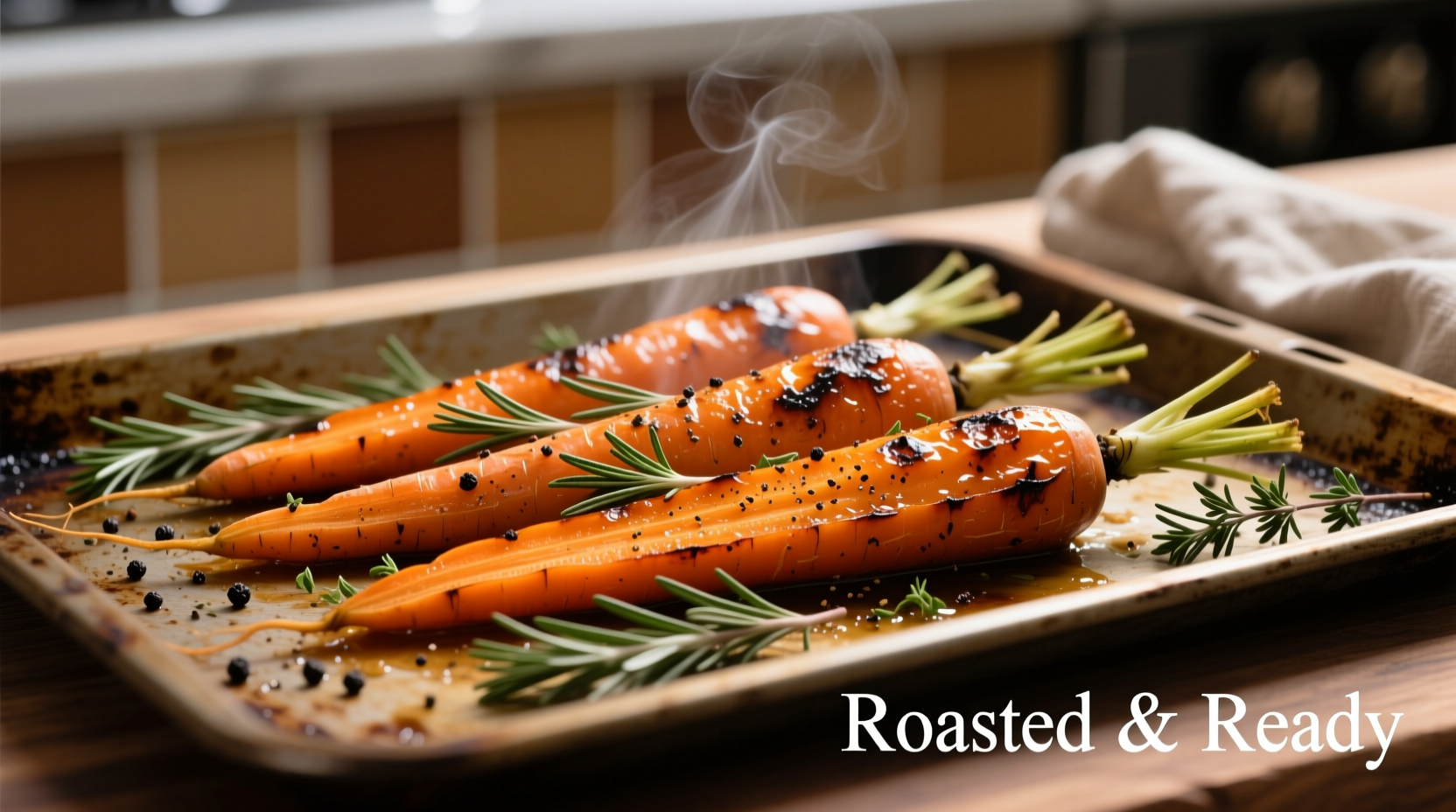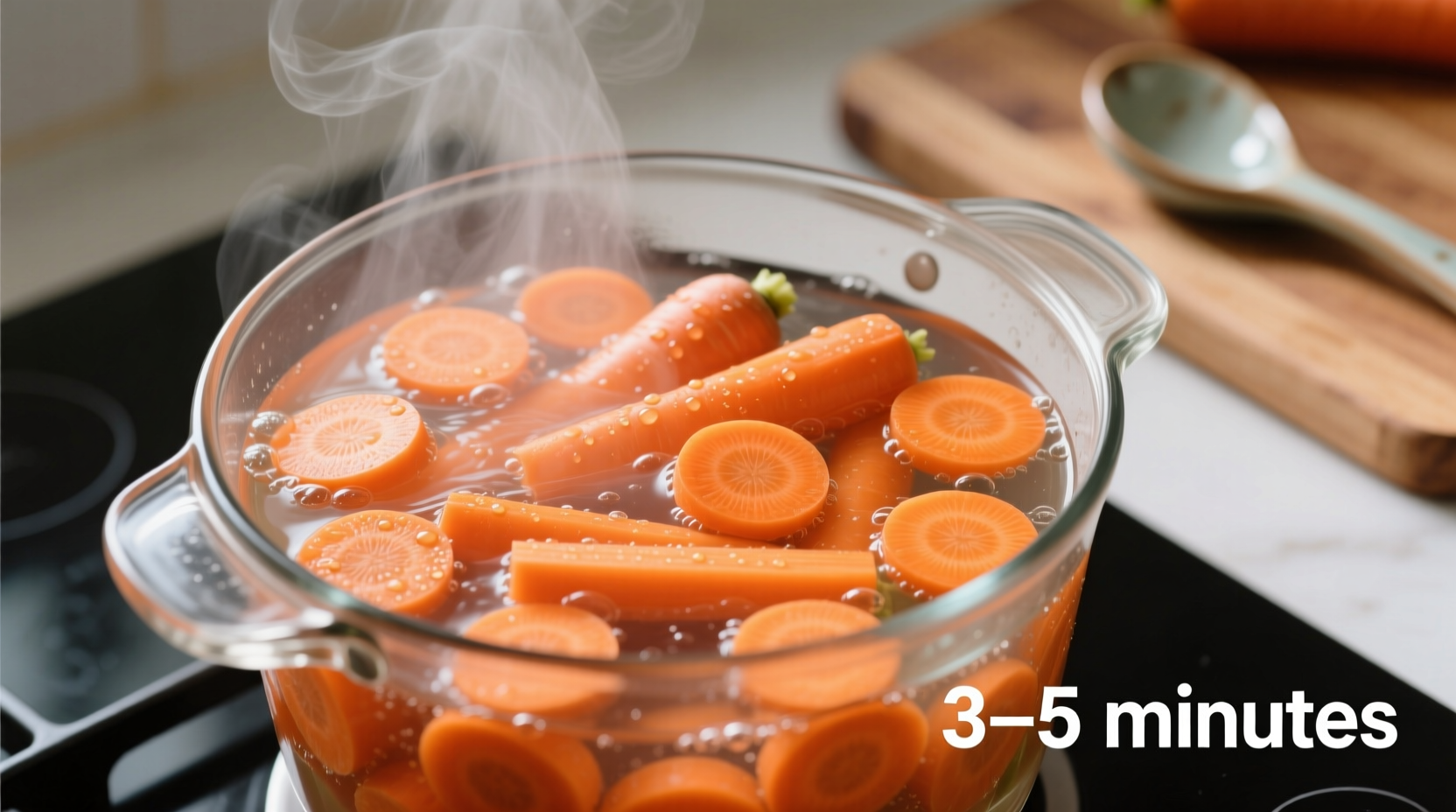Getting carrot cooking times right transforms this humble vegetable from bland or mushy to vibrant and flavorful. Whether you're preparing a quick weeknight side or an elegant dinner party dish, understanding the variables that affect cooking time ensures consistent results. This guide delivers exact timing for all major cooking methods, backed by culinary science and professional chef techniques.
Boiling Carrots: Precision Timing Guide
Boiling remains one of the quickest methods for cooking carrots. The key to perfect boiled carrots lies in starting with the right water-to-vegetable ratio and monitoring closely as they approach doneness.
| Carrot Type | Cut Style | Boiling Time | Texture Indicator |
|---|---|---|---|
| Baby carrots | Whole | 6-8 minutes | Fork pierces with slight resistance |
| Mature carrots | ¼-inch coins | 7-9 minutes | Slightly firm center |
| Mature carrots | ½-inch chunks | 9-12 minutes | No resistance when pierced |
| Mature carrots | Whole medium | 15-20 minutes | Fork slides through easily |
Professional chefs recommend starting timing only after water returns to a full boil. For vibrant color retention, add 1 tablespoon of vinegar to the boiling water. Drain immediately when done—residual heat continues cooking. Overboiling causes nutrient loss and mushiness, while undercooking leaves unpleasant hardness.
Steaming Carrots: Gentle Cooking Method
Steaming preserves more nutrients than boiling while delivering excellent texture control. This method works particularly well for achieving crisp-tender results that hold up in salads or side dishes.
Place carrots in a single layer in your steamer basket. Bring 1-2 inches of water to boil in the pot below, then add the basket and cover. Start timing immediately:
- Thin carrot coins (¼ inch): 5-6 minutes for crisp-tender, 7-8 minutes for soft
- Medium carrot chunks (½ inch): 7-8 minutes for crisp-tender, 9-10 minutes for soft
- Whole baby carrots: 6-7 minutes for crisp-tender, 8-9 minutes for soft
- Whole medium carrots: 12-15 minutes for crisp-tender, 18-20 minutes for soft
Test for doneness by piercing the thickest part with a fork or skewer. Perfectly steamed carrots should offer slight resistance at the center while being tender throughout. For enhanced flavor, add herbs like thyme or bay leaves to the steaming water.
Roasting Carrots: Flavor Development Through Time
Roasting transforms carrots through caramelization, developing complex sweet flavors. Temperature significantly affects cooking time—higher heat creates faster browning but requires careful monitoring.
Preheat oven to 400°F (200°C). Toss carrots with 1 tablespoon oil per pound and spread in a single layer on a baking sheet. Roasting times vary by size:
- Baby carrots: 15-18 minutes, flipping halfway
- ½-inch thick coins: 20-25 minutes
- ¼-inch thick coins: 15-20 minutes
- Whole medium carrots: 25-30 minutes
Carrots are done when fork-tender and caramelized at the edges. For even cooking, cut pieces uniformly. The USDA Food Safety and Inspection Service confirms that properly cooked carrots reach a safe internal temperature of 185-190°F (85-88°C), though this isn't typically measured for vegetables (USDA Vegetables Guidelines).
Sautéing Carrots: Quick Cooking Technique
Sautéing works best for thinly sliced or small-diced carrots, delivering fast cooking with beautiful browning. This method requires constant attention as cooking happens rapidly.
Heat 1-2 tablespoons of oil in a skillet over medium-high heat. Add carrots in a single layer:
- Thin coins (⅛ inch): 3-4 minutes for crisp-tender
- Medium coins (¼ inch): 5-6 minutes
- Diced (¼ inch cubes): 6-8 minutes
- Matchsticks: 4-5 minutes
Stir occasionally for even cooking. Carrots are done when golden at the edges and tender-crisp. For best results, don't overcrowd the pan—this steams rather than sautés. Professional kitchens often finish with a splash of acid like lemon juice or vinegar to brighten flavors.
Special Considerations for Perfect Carrots
Several factors influence optimal cooking time beyond basic method selection:
Carrot Maturity and Size Variations
Baby carrots (the small, packaged kind) cook faster than mature carrots due to their thinner diameter and processing. Whole mature carrots from the farmers market may require 25-30% more time than standard recommendations. The University of California Cooperative Extension notes that carrot density varies by variety and growing conditions, affecting heat penetration (UCCE Vegetable Guide).
Texture Preferences Matter
Your ideal texture determines precise timing:
- Crisp-tender (al dente): Carrot offers slight resistance when pierced
- Fully tender: Fork slides through with no resistance
- Soft-melting: Falls apart easily when pierced (ideal for mashing)
Most chefs recommend cooking carrots to crisp-tender for maximum flavor and nutrient retention. Overcooking destroys vitamin C and creates mushy texture.
Altitude Adjustments
At higher elevations, water boils at lower temperatures, extending cooking times. Above 3,000 feet, increase boiling/steaming times by 15-20%. The Colorado State University Extension provides detailed cooking adjustments for high-altitude environments.
Troubleshooting Common Carrot Cooking Issues
Even with precise timing, problems can occur. Here's how to fix them:
Carrots Remain Hard After Cooking
If carrots stay hard after recommended time, they likely weren't cut uniformly or your stove/oven runs cool. Solution: Continue cooking in 2-minute increments, testing frequently. For boiling/steaming, ensure water maintains a steady boil/steam throughout cooking.
Carrots Turn Mushy Too Quickly
Mushiness indicates overcooking or using carrots that were already soft. Prevent this by cutting uniformly, monitoring closely during the final minutes, and removing from heat source immediately when done. For roasted carrots, avoid overcrowding the pan which creates steam.
Uneven Cooking Results
Uneven cooking happens when pieces vary in size. Always cut carrots to consistent thickness. When boiling whole carrots, tie similar-sized carrots together to remove at appropriate times.
Maximizing Flavor and Nutrition
Timing affects more than texture—cooking method influences nutritional content. According to research published in the Journal of Agricultural and Food Chemistry, steaming preserves the most beta-carotene compared to other methods. For maximum nutrient absorption, pair carrots with a small amount of healthy fat like olive oil, as beta-carotene is fat-soluble.

Seasoning timing also matters. Add salt at the beginning of boiling to enhance flavor penetration, but wait until the end for roasting to prevent premature browning. Acidic ingredients like lemon juice or vinegar should be added after cooking to preserve vibrant color.
Advanced Timing Techniques
Professional kitchens use these timing strategies for perfect results:
- Shock and stop method: Immediately plunge boiled/steamed carrots into ice water to halt cooking
- Par-cooking: Partially cook carrots, then finish just before serving for perfect timing with other dishes
- Residual heat cooking: Remove carrots from heat 1-2 minutes early and let carryover heat finish the process
For meal prep, undercook carrots by 1-2 minutes, then reheat gently in a covered dish with a splash of water to maintain texture. This technique prevents the sogginess that often occurs with reheated vegetables.
Conclusion: Mastering Carrot Cooking Times
Perfect carrot cooking comes down to understanding how size, cut, method, and desired texture interact. By following these precise timing guidelines and incorporating the professional techniques shared, you'll consistently achieve carrots with ideal texture and maximum flavor. Remember that visual and tactile indicators matter more than strict timing—always test for doneness as carrots approach the end of their recommended cooking window.











 浙公网安备
33010002000092号
浙公网安备
33010002000092号 浙B2-20120091-4
浙B2-20120091-4